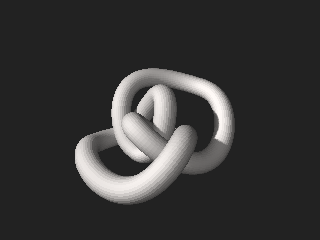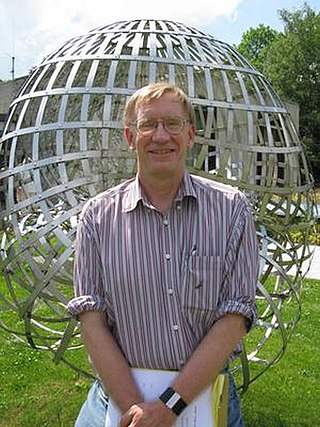Related Research Articles

In mathematics, topology is concerned with the properties of a geometric object that are preserved under continuous deformations, such as stretching, twisting, crumpling, and bending; that is, without closing holes, opening holes, tearing, gluing, or passing through itself.

John Willard Milnor is an American mathematician known for his work in differential topology, algebraic K-theory and low-dimensional holomorphic dynamical systems. Milnor is a distinguished professor at Stony Brook University and the only mathematician to have won the Fields Medal, the Wolf Prize, the Abel Prize and all three Steele prizes.

Sergei Petrovich Novikov is a Soviet and Russian mathematician, noted for work in both algebraic topology and soliton theory. In 1970, he won the Fields Medal.

Philip John Holmes is the Eugene Higgins Professor of Mechanical and Aerospace Engineering at Princeton University. As a member of the Mechanical and Aerospace Engineering department, he formerly served as the interim chair until May 2007.

Dennis Parnell Sullivan is an American mathematician known for his work in algebraic topology, geometric topology, and dynamical systems. He holds the Albert Einstein Chair at the City University of New York Graduate Center and is a distinguished professor at Stony Brook University.

In topology, the Vietoris–Rips complex, also called the Vietoris complex or Rips complex, is a way of forming a topological space from distances in a set of points. It is an abstract simplicial complex that can be defined from any metric space M and distance δ by forming a simplex for every finite set of points that has diameter at most δ. That is, it is a family of finite subsets of M, in which we think of a subset of k points as forming a (k − 1)-dimensional simplex (an edge for two points, a triangle for three points, a tetrahedron for four points, etc.); if a finite set S has the property that the distance between every pair of points in S is at most δ, then we include S as a simplex in the complex.
In applied mathematics, topological data analysis (TDA) is an approach to the analysis of datasets using techniques from topology. Extraction of information from datasets that are high-dimensional, incomplete and noisy is generally challenging. TDA provides a general framework to analyze such data in a manner that is insensitive to the particular metric chosen and provides dimensionality reduction and robustness to noise. Beyond this, it inherits functoriality, a fundamental concept of modern mathematics, from its topological nature, which allows it to adapt to new mathematical tools.

Ernest A. Michael was a prominent American mathematician known for his work in the field of general topology, most notably for his pioneering research on set-valued mappings. He is credited with developing the theory of continuous selections. The Michael selection theorem is named for him, which he proved in. Michael is also known in topology for the Michael line, a paracompact space whose product with the topological space of the irrational numbers is not normal. He wrote over 100 papers, mostly in the area of general topology.

Gustav Arnold Hedlund, an American mathematician, was one of the founders of symbolic and topological dynamics.

Yakov Matveevich Eliashberg is an American mathematician who was born in Leningrad, USSR.

Robert Edward "Rufus" Bowen was an internationally known professor in the Department of Mathematics at the University of California, Berkeley, who specialized in dynamical systems theory. Bowen's work dealt primarily with axiom A systems, but the methods he used while exploring topological entropy, symbolic dynamics, ergodic theory, Markov partitions, and invariant measures "have application far beyond the axiom A systems for which they were invented." The Bowen Lectures at the University of California, Berkeley, are given in his honor.
Euler calculus is a methodology from applied algebraic topology and integral geometry that integrates constructible functions and more recently definable functions by integrating with respect to the Euler characteristic as a finitely-additive measure. In the presence of a metric, it can be extended to continuous integrands via the Gauss–Bonnet theorem. It was introduced independently by Pierre Schapira and Oleg Viro in 1988, and is useful for enumeration problems in computational geometry and sensor networks.
Gordon Thomas Whyburn was an American mathematician who worked on topology.

Matthias Kreck is a German mathematician who works in the areas of Algebraic Topology and Differential topology. From 1994 to 2002 he was director of the Oberwolfach Research Institute for Mathematics and from October 2006 to September 2011 he was the director of the Hausdorff Center for Mathematics at the University of Bonn, where he is currently a professor.

Gunnar E. Carlsson is an American mathematician, working in algebraic topology. He is known for his work on the Segal conjecture, and for his work on applied algebraic topology, especially topological data analysis. He is a Professor Emeritus in the Department of Mathematics at Stanford University. He is the founder and president of the predictive technology company Ayasdi.
Serguei Barannikov is a mathematician, known for his works in algebraic topology, algebraic geometry and mathematical physics.

The offset filtration is a growing sequence of metric balls used to detect the size and scale of topological features of a data set. The offset filtration commonly arises in persistent homology and the field of topological data analysis. Utilizing a union of balls to approximate the shape of geometric objects was first suggested by Frosini in 1992 in the context of submanifolds of Euclidean space. The construction was independently explored by Robins in 1998, and expanded to considering the collection of offsets indexed over a series of increasing scale parameters, in order to observe the stability of topological features with respect to attractors. Homological persistence as introduced in these papers by Frosini and Robins was subsequently formalized by Edelsbrunner et al. in their seminal 2002 paper Topological Persistence and Simplification. Since then, the offset filtration has become a primary example in the study of computational topology and data analysis.
In topological data analysis, a subdivision bifiltration is a collection of filtered simplicial complexes, typically built upon a set of data points in a metric space, that captures shape and density information about the underlying data set. The subdivision bifiltration relies on a natural filtration of the barycentric subdivision of a simplicial complex by flags of minimum dimension, which encodes density information about the metric space upon which the complex is built. The subdivision bifiltration was first introduced by Donald Sheehy in 2011 as part of his doctoral thesis as a discrete model of the multicover bifiltration, a continuous construction whose underlying framework dates back to the 1970s. In particular, Sheehy applied the construction to both the Vietoris-Rips and Čech filtrations, two common objects in the field of topological data analysis. Whereas single parameter filtrations are not robust with respect to outliers in the data, the subdivision-Rips and -Cech bifiltrations satisfy several desirable stability properties.
In persistent homology, a persistent homology group is a multiscale analog of a homology group that captures information about the evolution of topological features across a filtration of spaces. While the ordinary homology group represents nontrivial homology classes of an individual topological space, the persistent homology group tracks only those classes that remain nontrivial across multiple parameters in the underlying filtration. Analogous to the ordinary Betti number, the ranks of the persistent homology groups are known as the persistent Betti numbers. Persistent homology groups were first introduced by Herbert Edelsbrunner, David Letscher, and Afra Zomorodian in a 2002 paper Topological Persistence and Simplification, one of the foundational papers in the fields of persistent homology and topological data analysis, based largely on the persistence barcodes and the persistence algorithm, that were first described by Serguei Barannikov in the 1994 paper. Since then, the study of persistent homology groups has led to applications in data science, machine learning, materials science, biology, and economics.
In topological data analysis, a persistence barcode, sometimes shortened to barcode, is an algebraic invariant of a persistence module that characterizes the stability of topological features throughout a growing family of spaces. Formally, a persistence barcode consists of a multiset of intervals in the extended real line, where the length of each interval corresponds to the lifetime of a topological feature in a filtration, usually built on a point cloud, a graph, a function, or, more generally, a simplicial complex or a chain complex. Generally, longer intervals in a barcode correspond to more robust features, whereas shorter intervals are more likely to be noise in the data. A persistence barcode is a complete invariant that captures all the topological information in a filtration. In algebraic topology, the persistence barcodes were first introduced by Sergey Barannikov in 1994 as the "canonical forms" invariants consisting of a multiset of line segments with ends on two parallel lines, and later, in geometry processing, by Gunnar Carlsson et al. in 2004.
References
- ↑ Robert Ghrist at the Mathematics Genealogy Project
- ↑ Vin de Silva, Robert Ghrist Homological Sensor Networks, Notices AMS, Januar 2007
- ↑ Bulletin of the American Mathematical Society. vol. 45, 2008, pp. 61–75, Online